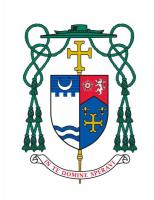Bishop-designate Siegel Creates Coat Of Arms
Diocese of Evansville Bishop-designate Joseph M. Siegel has provided The Message with his Coat of Arms.
The Coat of Arms
The bishop’s Coat of Arms is composed of a shield, which is the central and most important part of the design; a scroll with the bishop’s episcopal motto; and the external ornamentation. The design is described as if the description was being given by the bearer, from behind, with the shield being worn on the left arms. By heraldic tradition, the arms of the bishop of a diocese, called an “Ordinary,” are joined with the arms of his jurisdiction, in this case the Diocese of Evansville, which are seen in the left side of the design.
The left side – Diocese of Evansville
The crescent in the Diocese of Evansville coat of arms symbolizes two important elements. Evansville is situated on a bend of the Ohio River. As a result, it can suitably be called a “Crescent City.” The crescent symbolizes the Blessed Virgin Mary, who is the patroness of the diocese.
Appearing immediately below the crescent is the representation of a crenellated battlement or fortification wall. This represents the original Fort Vincennes, established as a trading post, which suggests that the diocese derives from historic Vincennes, Indiana, and that the Catholic Faith is a mighty fortress.
The two waves at the bottom of the shield represent the waters of the Wabash and Ohio Rivers. The Wabash forms the western boundary of the diocese, and the Ohio forms its southern boundary. Spiritually, the waves represent the cleansing waters of Baptism.
The right side – Bishop-designate Siegel
Bishop-designate Siegel has adopted a design that reflects his heritage and his ministry as a priest and bishop.
These arms incorporate red, blue, silver and gold – the colors employed in the arms of the Siegel family. The shield is divided by a chevron, to be reminiscent of a “carpenter’s square,” to pay particular honor to the Bishop’s baptismal patron, Saint Joseph, the foster father of Jesus.
In the upper portion of the design is a rose, to honor both the Blessed Virgin Mary, in her title of Mystical Rose, and Saint Therese, the Little Flower, to whom Bishop Siegel has particular devotion. The rose also is the symbol of the Respect Life cause. in which the Bishop has been active as a priest and bishop. Also in the upper portion is a silver rampant lion that is taken from the arms of the Wallace family of the mother of the Bishop. The lion is also the symbol of Saint Mark the Evangelist, also a baptismal patron of the Bishop.
In the lower portion of the design is a gold Moline cross (each arm terminates in what looks like an anchor), which is classic charge used in Benedictine arms. By its presentation here, the Bishop calls to reflection his profound affection for the Order of Saint Benedict and Benedictine spirituality. The Moline cross is placed below and between two gold fleur-de-lis, the lily form that is often associated with the Blessed Virgin and St. Joseph, and which is found in the arms of the Diocese of Joliet, the local Church in which the Bishop Siegel was baptized, ordained and served as auxiliary bishop.
Episcopal Motto
For his episcopal motto, Bishop-designate Siegel has selected “In Te Domine Speravi.” This quotation is taken from the closing responsories of the Te Deum and is also alluded to in Psalm 33:22. In this phrase, “In you Lord, I have placed my hope,” Bishop-designate Siegel expresses the faith of all Christians – that is, by placing our hope in Christ and in His Protection, all we are called to be can be achieved.
Ornamentation
The achievement in completed by the external ornamentation, which are a gold processional cross that is placed in back of the shield and extends above and below the shield; and the pontifical hat, called a “galero,” with its six tassels in three rows on either side of the shield, all in green. These are the heraldic insignia of a prelate of the rank of bishop, by instruction of The Holy See, of March 31, 1969.
Information for this story is taken from the original design and description of Bishop-desgnate Siegel’s Coat of Arms, its adaption and its update. Original design and description by Deacon Paul J. Sullivan, Deacon of the Diocese of Providence, R.I. Design adapted by Dawn Evans. Design updated by Craig Miller.



